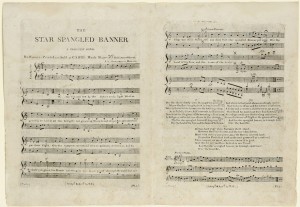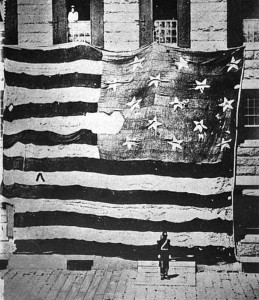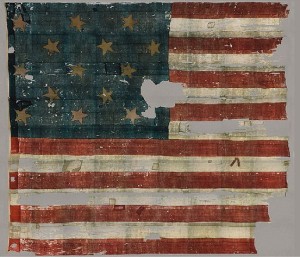 An 1814 first edition copy of the sheet music and lyrics of “The Star Spangled Banner” sold for over $500,000 at a Christie’s auction in New York today. The pre-sale estimate was between $200,000 and $300,000, but the rarity of this piece drove the bidding way up. There are only 11 known copies of this edition, and the other 10 all belong to institutions, among them the Library of Congress and the Pierpont Morgan Library. This is the only one in private hands.
An 1814 first edition copy of the sheet music and lyrics of “The Star Spangled Banner” sold for over $500,000 at a Christie’s auction in New York today. The pre-sale estimate was between $200,000 and $300,000, but the rarity of this piece drove the bidding way up. There are only 11 known copies of this edition, and the other 10 all belong to institutions, among them the Library of Congress and the Pierpont Morgan Library. This is the only one in private hands.
It was bound into a book in around 1820 along with sheet music from 48 other popular songs of the time. A note on one of the other songs in the binding mark it as belonging to Mary Barnitz of York, Pennsylvania, or her father George, brother of Revolutionary War hero Joshua Barnitz and uncle of Joshua Jr. The latter fought in the war of 1812 with the 5th Maryland Regiment and was himself a witness to the 1814 bombing of Fort McHenry, the star-shaped Baltimore fort whose shelling inspired Francis Scott Key’s immortal lyrics.
Key, then a young lawyer and amateur poet, is said to have boarded a truce vessel in Chesapeake Bay in an effort to negotiate the release of a detained American doctor, according to documents from the Smithsonian National Museum of American History.
But Key was himself detained overnight by Royal Navy officials to ensure their plans for the assault on the fort were not revealed to its defenders.
His vantage point aboard the British ship is said to have offered sweeping views of the ensuing battle, spanning the night of September 13 to the morning of September 14, 1814.
“By the dawn’s early light,” Key saw that the fort’s flag — torn and singed from near-constant shelling — had remained flying above its walls. The inspiring words later were put to existing music and printed by Baltimore music publisher Thomas Carr.
The poem was an immediate runaway success. It was published in newspapers and pamphlets as “The Defence of Fort McHenry” and circulated widely. Key’s brother-in-law set the words to the tune of another big success of the era: “The Anacreontic Song,” written by John Stafford Smith in the mid-1760s as a drinking song, basically, for a British gentleman’s club called the Anacreontic Society. (Here’s a YouTube of the Georgia Tech glee club doing a rousing rendition of the original.)
![]() Carr capitalized on its instant success and rushed the lyrics and music into print by November 18th, making 2 glaring errors in the process. He neglected to put Francis Scott Key’s name on it as the author, and he subtitled it “A Pariotic Song” instead of “A Patriotic Song.” Shortly thereafter he issued an amended version which corrected the mistakes, but of course that only makes the first run with the typo more valuable.
Carr capitalized on its instant success and rushed the lyrics and music into print by November 18th, making 2 glaring errors in the process. He neglected to put Francis Scott Key’s name on it as the author, and he subtitled it “A Pariotic Song” instead of “A Patriotic Song.” Shortly thereafter he issued an amended version which corrected the mistakes, but of course that only makes the first run with the typo more valuable.
The star-spangled banner itself, the 30-by-34-foot flag (the largest battle flag in existence) that survived a night of constant artillery shelling, is currently on display at the Smithsonian’s National Museum of American History in Washington, D.C. They also have an excellent online exhibition that covers the history of the flag and the song. Don’t miss the interactive zoomable flag with all kinds of facts about its history, damage and conservation.

